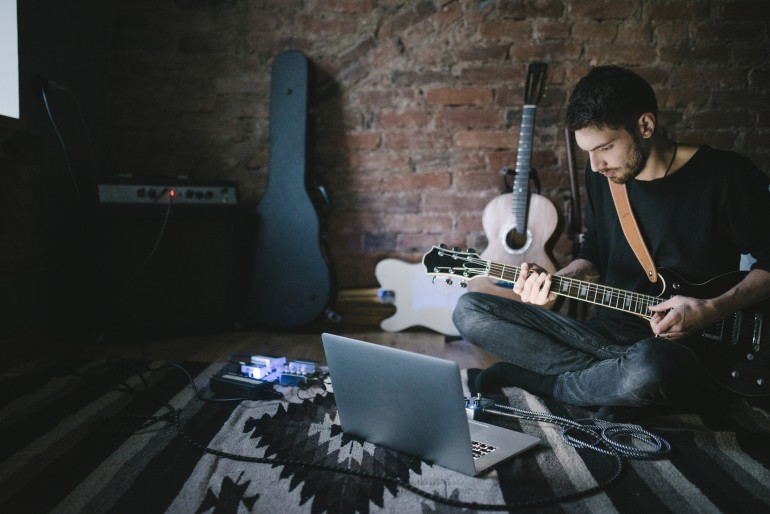Tips for Co-Writing Songs When You Can’t Be in the Same Room

While I am writing this article, the world is battling COVID-19 and social distancing is curtailing the in-person collaborations that are so often the way songs are written. For those who are unable to write and record songs during face-to-face sessions there are alternatives.
Co-Writing Separately
My first major-label cut was written with a songwriter whom I had never met. I lived in Los Angeles, he lived in Nashville. This was 1989—pre-Internet—and he mailed me a cassette with a melody he had written. I was tasked to write a lyric. When I finished the lyric, I recorded a rough version and mailed it to my collaborator. He phoned me to share his suggestions. I tweaked the lyric accordingly and mailed the new version. This process was repeated several times until we were both happy with the finished song. In this instance we were never in the same room or communicating during the times when we were each working on our respective contribution to the song. This method of co-writing is still used, but of course, now the recordings are sent digitally.
Don May, who is signed to Curb/Word Music Publishing, is among those writers who prefer to do their long-distance collaborating via email. May stated,
“As someone who writes a lot (mostly) on my own, when I do write long-distance, I find I’m better when I can spend some real quality time on something.”
This method of writing is often used by those who create musical tracks and by the topliners who contribute the melody and lyrics to backing tracks. It entails each writer doing his or her work individually and swapping files and emails back and forth. File sharing sites such as Disco and Dropbox can be used to send large files. In some instances, I sent a lyric or a melody to a collaborator; in other cases, they sent a draft of a melody or lyric to me. Other times, one of us sent a portion of a song, for example a verse or chorus with a melody and lyric. In these instances, we each worked separately, revising what the other had sent, with no face-to-face contact during the writing of the song.
Co-Writing in Real Time
Many songwriters who write long-distance prefer to interact in real time with their co-writers. They feel their creativity is stoked by the spontaneous exchange of creative ideas. By using video chat technology such as Google Hangouts, Zoom, Skype, Facetime, and Facebook Messenger, multiple writers in different locations can see and interact with each other over the internet or phone.
Portland-based hit songwriter Jeremy Bircher and his Honolulu-based collaborator Josh Jones are an ocean apart, yet managed to co-write and record the latest global theme song for Coca-Cola (“Taste the Feeling”) along with Scott Fritz. Bircher and Jones co-write live on FaceTime and work up the production by sending project files back and forth. Jeremy’s top tip for long-distance writing is to have a recorder running the entire time, stating:
“You never know when a chorus melody or lyric idea will pop up out of nowhere, and having it instantly saved in the moment helps us from losing that idea or having to stop our flow to record.”
Following are some additional tips from writers who regularly co-write during “live” online sessions.
- Take some time to get to know your co-writer. Your conversation will make the writing process flow more smoothly and might lead to ideas for your song.
- Take care of business before writing. Clarify how the writing and publishing shares will be split; how the demo will be recorded—and the anticipated demo budget. Establish how the song will be pitched and whether all writers are on board to receive professional critiques and to rewrite the song.
- Discuss your hopes and intentions for the song. Is one of the writers expecting to record it on his or her upcoming album—and is expecting it not to be pitched to other artists? Is the intention to create a song that will be pitched for sync licensing? Or is the goal to write something that will be pitched for artists’ projects?
- Consider using a program such as Google Docs, which allows multiple users to contribute to the same document and edit it. In addition to updated versions of the lyric, the document you set up can include information such as the chords, the number of beats per minute, each writer’s contact information and PRO affiliation, as well as the song’s date of creation.
- Come prepared, as you would for an in-person co-writing session. Have your ideas ready, but remain flexible and open to where the muse leads you.
- When writing with someone who is unfamiliar with the programs you’ll be using, do a test prior to your writing session.
- Be cognizant of the online atmosphere you are creating. Avoid unnecessary distractions and work in a location that is conducive to your being creative.
It is said that Shakespeare wrote King Lear, Macbeth, and Antony and Cleopatra while quarantined during the bubonic plague. Whether you write long-distance because of a need to isolate during these trying times, or you choose to write remotely to gain access to an entire world of collaborators, with the technology that is available, you can safely co-write from the comfort of your home.
Stay careful, healthy, and creative!






Community
Connect with BMI & Professional Songwriters